Meltdown & Spectre: Analyzing Performance Impacts on Intel's NUC7i7BNH
by Ganesh T S on March 23, 2018 4:15 PM EST- Posted in
- Systems
- Spectre
- Benchmarks
- Meltdown
BAPCo and Futuremark Benchmarks
BAPCo's SYSmark 2014 SE is an application-based benchmark that uses real-world applications to replay usage patterns of business users in the areas of office productivity, media creation and data/financial analysis. In addition, it also addresses the responsiveness aspect which deals with user experience as related to application and file launches, multi-tasking etc. Scores are meant to be compared against a reference desktop (the SYSmark 2014 SE calibration system in the graphs below). While the SYSmark 2014 benchmark used a Haswell-based desktop configuration, the SYSmark 2014 SE makes the move to a Lenovo ThinkCenter M800 (Intel Core i3-6100, 4GB RAM and a 256GB SATA SSD). The calibration system scores 1000 in each of the scenarios. A score of, say, 2000, would imply that the system under test is twice as fast as the reference system.
We see that the patching does have an impact on the performance. It ranges from around 5% for the Office Productivity scenario to around 10% for the Responsiveness metric.

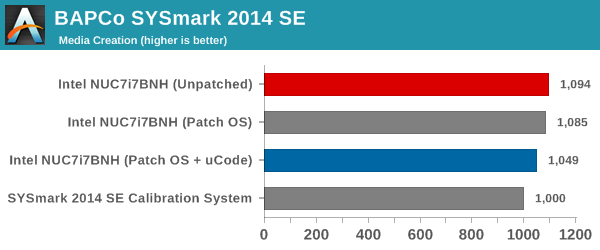

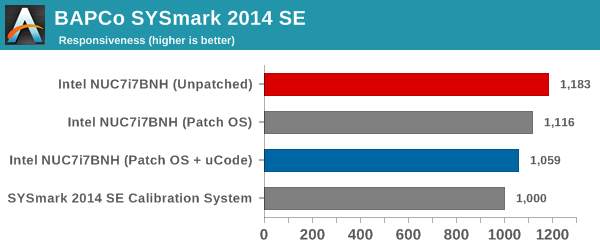
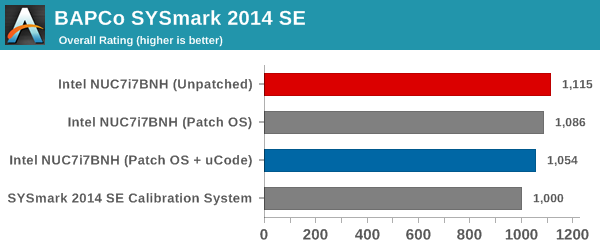
SYSmark 2014 SE also adds energy measurement to the mix. We see that the patched system, despite being slower, consumes lower energy for the completion of the tasks.
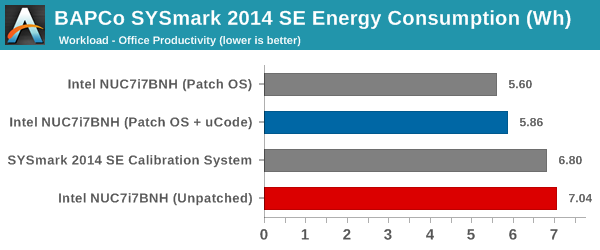
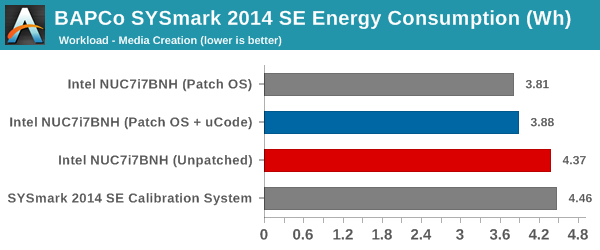
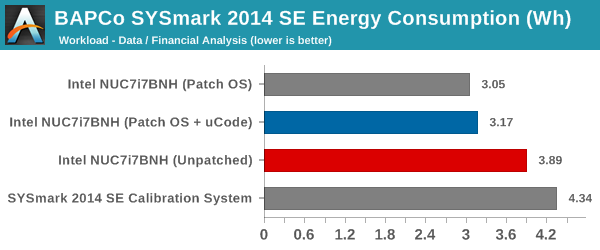
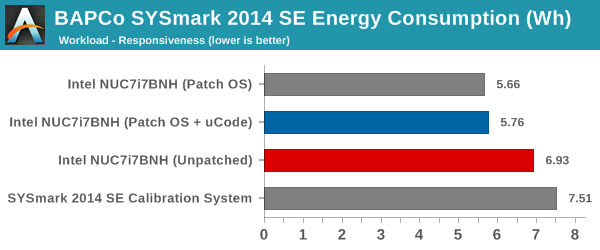

Futuremark PCMark 10
UL's PCMark 10 evaluates computing systems for various usage scenarios (generic / essential tasks such as web browsing and starting up applications, productivity tasks such as editing spreadsheets and documents, gaming, and digital content creation). We benchmarked the configurations with the PCMark 10 Extended profile and recorded the scores for various scenarios. These scores are heavily influenced by the CPU and GPU in the system, though the RAM and storage device also play a part. The power plan was set to Balanced for all the PCs while processing the PCMark 10 benchmark.
Similar to SYSmark 2014 SE, we see performance impacts in all the PCMark 10 scenarios also. For example, the Essentials workload score for the fully patched system is around 6.5% lower than the unpatched system. The gaming workload doesn't seem to be affected much by the patching, though. The overall score is around 2.3% lower.





Futuremark PCMark 8
We continue to present PCMark 8 benchmark results (as those have more comparison points) while our PCMark 10 scores database for systems grows in size. PCMark 8 provides various usage scenarios (home, creative and work) and offers ways to benchmark both baseline (CPU-only) as well as OpenCL accelerated (CPU + GPU) performance. We benchmarked select PCs for the OpenCL accelerated performance in all three usage scenarios. Since these scores are heavily influenced by the CPU in the system, it is not surprising to see a performance impact. The patched configuration, on average, scores around 2% lower than the unpatched one.



Miscellaneous Futuremark Benchmarks

PCMark 7's PCMark Suite shows a 4% performance loss.

3DMark 11's entry level score and 3DMark 2013's Cloud Gate score actually end up better after the patch, but, 3DMark 2013's Ice Storm score shows a performance loss of more than 13%.


Futuremark PCMark 8 Storage Bench
PCMark 8 has a storage bench where certain common workloads such as loading games and document processing are replayed on the target drive. Results are presented in two forms, one being a benchmark number and the other, a bandwidth figure. We ran the PCMark 8 storage bench on the ADATA NVMe SSD in all the configurations.


While the absolute score is just around 1.3% lower for the patched configuration, the storage bandwidth is around 29% worse. This significant performance loss is partly due to the NVMe drive performance now being CPU bound. It is highly likely that SATA drives will not experience such a drastic performance loss due to the patching.










83 Comments
View All Comments
rocky12345 - Sunday, March 25, 2018 - link
What I would like to see is for tests done on older cpu's like ivy's and sandy bridge since that is where Intel said the biggest hits in performance would be.Ryan Smith - Monday, March 26, 2018 - link
It's on the list. The microcode is shipping, but we can't actually cover it until either an updated BIOS lands for one of the old mobos we still have, or MS publishes the microcode through Windows Update.CircuitBoard - Sunday, March 25, 2018 - link
Well, looks like storage trend that going to NVMe would be slower than i've expected...piasabird - Sunday, March 25, 2018 - link
It should be illegal for Intel to continue to sell defective parts.HStewart - Sunday, March 25, 2018 - link
Some one purposely creating software virus that effects the security of a system does not mean the system is defected - the real problem here is people that create the virus. That does not mean the system should be updated to prevent such attacks on system in the future.Keep in mind these issues are just on Intel - also on ARM and AMD. And stating that it is illegal for Intel and not including others should complete bias against Intel
mkaibear - Monday, March 26, 2018 - link
It should also be illegal for Ford to sell cars which can go faster than the speed limit. And it should be illegal for Marshall to sell guitar amps which can go loud enough to damage hearing. And it should be illegal for Cisco to sell border routers which can pass traffic to Tor.... Or alternatively we can accept that the problem is people using what is sold for an illegal purpose, like rational humans...
FourEyedGeek - Monday, March 26, 2018 - link
They are not defective, a flaw / exploit has been discovered but they work as intended.Duncan Macdonald - Monday, March 26, 2018 - link
Can you do a similar test on an AMD Ryzen system. I would be interested to see the results there (especially whether Microsoft enables the performance sapping Meltdown fixes on a CPU that does not need them).casperes1996 - Monday, March 26, 2018 - link
Nice read as always. I'd like to suggest a follow-up, looking at how the performance impact is on Linux/macOS, to see if other Ones are hit in the same way as WindowsAdam Slivinsky - Monday, March 26, 2018 - link
Seeing as you are using Steve Gibson's InSpectre tool https://www.grc.com/inspectre.htm in the screen shots, it might be nice mention it and link to it instead of just showing it in the images that spiders can not read.